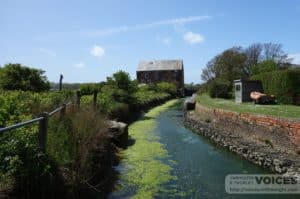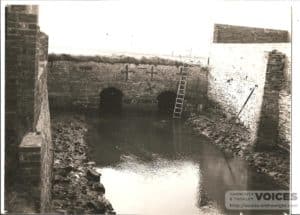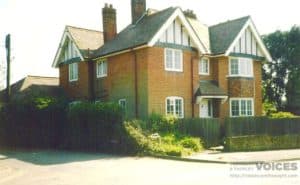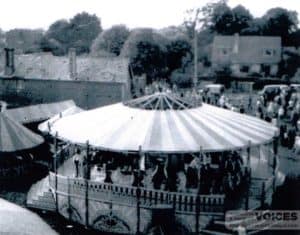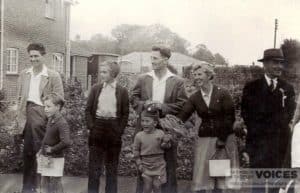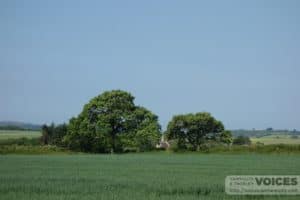Yarmouth C. of E. Primary School : Mrs Sylvia Sharp Head teacher Christmas 1968 – 1994
At Christmas 1968 I took over the headship of Yarmouth School from Mrs V.A.Barton, who had been head for 32 years. It was then an infant/junior school of 104 pupils , with 3 classrooms created by dividing one long hall into 3 by sliding ½ glass screens.
Mrs D. Vanson and Miss J. Bull were established as assistant teachers – both 12 years older than me! Mrs J Hall was part time assistant for the reception class of 34 pupils.
In June 1969 after I’d been at the school for 6 months, an electrical fire broke out in the southernmost classroom, luckily overnight so the classroom was devoid of humans. Mr. Holloway the then caretaker wakened me in the adjoining schoolhouse at 7.15a.m. and the fire brigade were on the scene within 20 minutes. School was closed for 2 days whilst all the staff sifted through the smoke and soot–blackened equipment to see what could be salvaged.
In September ’71 the ten and eleven year olds were transferred to West Wight Middle School – the start of the 3 tier system being introduced on the Island – leaving Yarmouth with the age range 5 – 9 years.
As Yarmouth is surrounded on 3 sides by sea, and we were no longer allowed to teach children to swim in the sea, we decided to build a swimming pool. A very active and supportive PTA helped to organise several extraordinary events to raise money .
One of the most ludicrous was a Dads versus Mums football match at the Recreation ground, where the men dressed as women and women as men, with feigned injuries to raise the laughs. Stretcher bearers carried off the ‘injured’ to howls of laughter and indignation. It wasn’t till after the match that we discovered that one of the dads had sustained a genuine injury and had to be taken off to A. and E.
* John Golding remembers being delegated to play in goal, for the mums – the only man on the team, wearing a wig of long blond curls and not allowed in the mums ‘changing room!
Our ‘It’s a Knockout ‘ competition delighted participants and spectators, especially when the Head Teacher was deluged with an entire dustbin of water by Mr. Roger Giles of Harwoods.
During our barbecue at Compton Beach the dads were beachcombing for firewood and gratefully received a huge pile of wood donated by a complete stranger. His donation had been burnt before our benefactor discovered his mistake – his party was half a mile away along the beach!
We finally raised the £780 to buy the pool, and the PTA dads, led by Michael Persse, constructed it.
It was a worthwhile effort as only 2 children left the school as non swimmers in ensuing years ( both of them had excuse notes to prevent them from swimming more often than was necessary!)
Building work to improve accommodation, designed by Mr. Biggs
( Architect), was started in the early 1970’s. Once again, the P.T.A. raised most of the money with funds topped up by the D.E.S.
( Department of Education and Science – what happened to them?)
Teaching and building work continued in parallel. At one time a class was in session with only a tarpaulin between builders and students ( Health and Safety eat your heart out!)
When work was completed we had windows that children could see out of, and spacious rooms with carpets and new furniture more suitable for small children – luxury indeed.

Yarmouth School 2013 showing new windows
We also had our own kitchen and cook. Prior to that, meals were prepared at Shalfleet or West Wight and sent to us in containers , by van. We had had to use the reception room for dining with monitors, elected weekly, to set up tables and benches for lunch.
* Mrs Mary Lord, reception teacher from 1974, wondered at the time of her interview whether her ability to move furniture about, had contributed in part to her appointment!
In the second ’87 Great Storm, conditions were so worrying that we gathered all the children into the hall, which is large and with relatively few windows. Ten minutes later something crashed into the west- facing windows of the reception class and glass shattered everywhere. The suspended ceiling was dislodged and tiles scattered. As I was phoning County Hall from the office, a dinghy blew past the window and over the wall into Mill Road. We all survived to tell the tale, but it was hair raising at the time.
One afternoon in ’89 a man entered my classroom. Obviously not in full possession of his faculties, he told me he was a member of the S.A.S., rambling fairly incoherently for several minutes whilst I was gently manoeuvring him towards the exit. As it was nearly time for the children to leave schooI phoned the police for protection for the children and shouted to the men repairing the school roof to keep watch!
Drama was much more enjoyable when we were all involved in pantomimes!
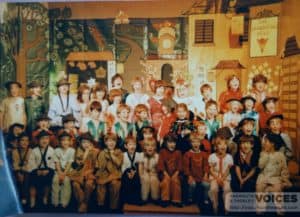
Yarmouth School pantomime 1970s
Mrs. Edna Crosbie proposed that we should have a pantomime at the school, involving all the children and parent volunteers, to raise money for school funds. We readily agreed and a good time was had by all who took part, and more importantly by the town’s community as audience. What a fun way to rally support!
We repeated this venture every second year until my retirement in 1994. Our last pantomime was entitled ‘In at the Sharp End’!
All requests for building work at Yarmouth School, although written on official request forms, were written in doggerel verse (* Alu can letter) by the ‘Poet Looreate’ ,

Mrs. Sharp’s Alu cans letter
as indeed was my retirement note and a poem for our OFSTED inspectors, when we were chosen for a pre OFSTED trial, from which we emerged triumphant. The County Hall Architects Department (AKA Ivor Trowell) often replied in rhyme. The OFSTED inspectors sent their report in rhyme, set to music, and requested us to sing it to the School Governors at our WRAP party.
Yarmouth was only a little school, but we did have fun. I had lovely pupils, a dedicated staff and supportive parents. What more could you ask?

Mrs Sharp at her leaving party July 1994
The only thing that the children will remember of their Head Teacher is her idiocyncratic kaftans and painted toenails – both deliberately adopted after noting the children’s enthusiastic reaction to the Afton Festival crowds!
* Not true, Mrs Sharp, you are remembered with much affection for your exuberant, encouraging and positive approach to learning. Miss Bull remembers you starting every day with a jolly comment.

